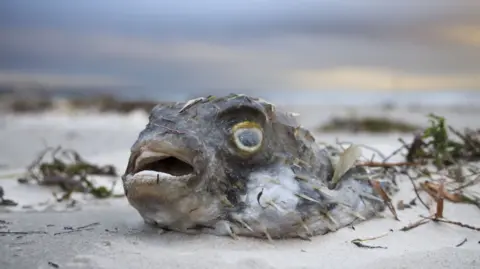BBC News, Sydney
An algal bloom catastrophe which has turned usually pristine South Australian waters toxic green and suffocated masses of marine life is a “natural disaster”, the state premier has declared.
The algal bloom – a rapid increase in the population of algae in water systems – has been spreading since March and is now twice the size of the country’s capital territory.
The federal government has unveiled an assistance package of A$14m ($9m; £6.7m) but refused to designate the event a natural disaster – a term usually used for cyclones, floods and bushfires and which would trigger a greater response.
Authorities say more than 400 species of marine life have died and local industries are suffering.
Algal bloom is naturally occurring but is caused by ocean warming, marine heatwaves, and nutrient pollution – all a direct result of climate change.
“This is a natural disaster and should be acknowledged as such… I think politicians can do themselves a disservice when they get caught up in technicalities,” South Australian Premier Peter Malinauskas told the Australian Broadcasting Corporation (ABC) on Tuesday.
He announced his government would match the federal government’s A$14m in funding, with money to go towards research, clean up, and industry support measures.
 EPA
EPAGreens Senator for South Australia Sarah Hanson-Young is among those openly criticising the federal government, accusing them of underplaying the situation.
“If this toxic algal bloom was wreaking havoc on Bondi Beach or on the North Shore in Sydney, the prime minister would have already been on the beach with a response,” she said.
However, federal Environment Minister Murray Watt on Monday said while the bloom and its impacts were “incredibly disturbing”, the catastrophe did not meet the definition of a natural disaster under the country’s laws.
The bloom – which now stretches from Coorong to the Yorke Peninsula, an area about double the size of the Australian Capital Territory – is decimating the local environment and lining the coastline with dead wildlife.
“It is like a horror movie for fish,” Brad Martin – from OzFish, a non-profit organisation that protects fishing habitats – told the BBC in May.
But the event is also wreaking havoc on the local economy. Representatives of the fishing industry say some of their members have had no income for at least three months.
“I’ve got fishermen in tears on the phone,” Ian Mitchell – who works as a middleman between fishers and retailers – told the ABC.